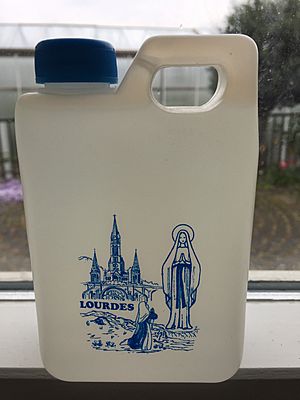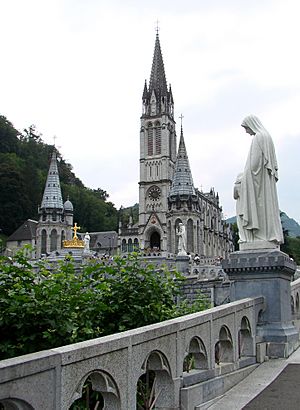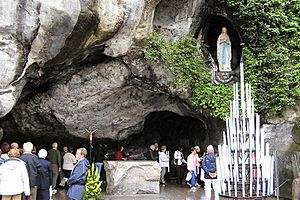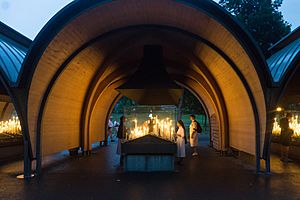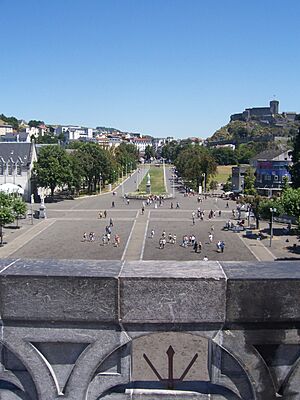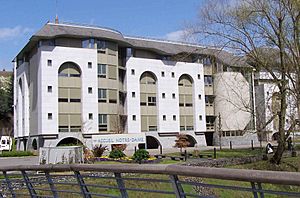Sanctuary of Our Lady of Lourdes facts for kids
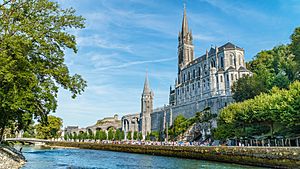
The Sanctuary of Our Lady of Lourdes is a special Catholic place in Lourdes, France. It is a very important site for pilgrimages, dedicated to Our Lady of Lourdes. The sanctuary has many religious buildings and monuments. These are built around the Massabielle grotto, where important events happened in 1858.
Some of the main buildings are three large churches called basilicas. These are the Basilica of Our Lady of the Immaculate Conception, the Rosary Basilica, and the Basilica of St. Pius X. People often call them the upper, lower, and underground basilicas.
Many sick and disabled people visit the sanctuary. This is because of the Lourdes water, which flows from the grotto. Many believe this water can bring miraculous healings. The local Roman Catholic Diocese of Tarbes-et-Lourdes owns and manages the area. They offer religious activities, offices, and places for sick pilgrims and their helpers to stay.
Besides the grotto and basilicas, the sanctuary has fountains with Lourdes water. There are also baths for people to dip in the water. An open area called an esplanade is used for processions. There is also a calvary (a path with statues showing Jesus's journey). The sanctuary covers a large area of about 52 hectares (128 acres).
Lourdes is one of the most visited Catholic shrines in the world. About four million people come here every year. The Massabielle grotto is the most famous spot. Hundreds of copies of it, called "Lourdes grottos," exist worldwide.
Contents
History of the Sanctuary
The Sanctuary of Our Lady of Lourdes started because of special events in 1858. A young girl named Bernadette Soubirous said she saw a "lady" many times.
Bernadette's Visions
On February 11, 1858, Bernadette Soubirous was 14 years old. She was playing near the Massabielle grotto with her sister and a friend. The grotto was by the Gave de Pau river. Bernadette said she saw a "lady" standing on a rose bush in a niche above the grotto.
At that time, the grotto was outside the town. It was a messy place used for animals and garbage. Bernadette's sister told their parents about the vision. Her parents told them not to go back. But Bernadette kept going to the grotto.
From February 11 to July 16, 1858, Bernadette saw the "lady" 18 times. The "lady" eventually told Bernadette she was the Immaculate Conception. This was a special title for the Virgin Mary that Pope Pius IX had announced in 1854. This made the local priest, Dominique Peyramale, believe Bernadette's visions were real.
Building the Sanctuary
During her visions, the "lady" gave Bernadette instructions. Bernadette was told to drink water from a spring that would appear in the grotto. She was also told to wash herself with it. The "lady" also asked her to tell the priests to build a chapel at the grotto. People were to come there in processions.
After the visions, more and more people became interested. Visitors and pilgrims came from far away. They were drawn by stories of the visions and miracles.
In 1861, three years after the visions, the local priest Dominique Peyramale and Bishop Bertrand-Sévère Laurence bought the grotto and the land around it. They immediately started making the area easier for pilgrims to visit. They also began building the first church, now called the "Crypt."
In 1864, a French artist named Joseph-Hugues Fabisch made a statue of Our Lady of Lourdes. It was based on Bernadette's descriptions. This statue is now a famous symbol of Lourdes. It stands in the niche where the Virgin Mary appeared to Bernadette.
Over time, the ownership of the sanctuary changed. In 1910, the French government took control of the land from the Church. But later, in 1941, Church officials were able to get the sanctuary back.
How the Sanctuary is Run
The Bishop of Tarbes and Lourdes is in charge of the sanctuary's spiritual side. He chooses a local leader called the rector. The sanctuary is run separately from the local church in Lourdes.
Many people work at the sanctuary. There are priests from all over the world. There are also many full-time and seasonal workers. They help with different tasks. The sanctuary relies on donations to operate.
When to Visit
The sanctuary is open all year. In winter, there are fewer visitors. The schedule for services and activities is also reduced. The winter season runs from November 1st (All Saints) until Easter. On February 11th, the Feast of Our Lady of Lourdes, there is usually a full day of activities.
The busiest time is between Easter and All Saints' Day. During this time, there are many religious activities. These include Mass, processions, adoration of the Blessed Sacrament, and the sacrament of reconciliation (confession). Many activities are offered in different languages.
The grounds are open from 5 AM until midnight every day. Outside these hours, you can still reach the grotto through a special gate.
It is estimated that 200 million people have visited the shrine since 1860. The Catholic Church has officially recognized 72 miracle healings. The 72nd healing was of Antonietta Raco, which was recognized on April 16, 2025.
Lourdes Water
Lourdes water comes from a spring inside the Massabielle grotto. This is the same spot where Bernadette found it. You can see the original spring inside the grotto, protected by glass.
Many pilgrims drink Lourdes water because they believe it has healing power. You can get the water from taps located near the grotto. Scientists have studied the water. They found it has no special scientific or medicinal properties. However, for pilgrims, the water is a strong symbol of their faith. Many people buy statues and rosary beads with small amounts of the water. They also take large containers of it home.
Special Processions
Processions are special walks held at the sanctuary. The torchlight procession is very well-known and beautiful to see.
Blessed Sacrament Procession
The Blessed Sacrament procession happens every day at 5:00 PM. It starts at an outdoor altar across the river from the grotto. Sick pilgrims lead the way. A priest, bishop, or cardinal follows, carrying a monstrance. This holds the Blessed Sacrament (a special host used in Catholic worship).
People carrying candles and incense walk with the Blessed Sacrament. Doctors and groups of pilgrims also join. The procession crosses the river and goes along the esplanade. It ends in the St. Pius X underground basilica. Here, pilgrims with disabilities can easily reach the altar. During the procession, there are prayers, hymns, and chants in many languages. After everyone gathers, there is a time of Eucharistic adoration, followed by a blessing for the sick.
If the weather is very bad, the procession takes place inside one of the basilicas.
Torchlight Procession
The torchlight Marian procession happens every day at 9 PM. It starts near the grotto and moves through the esplanade. It ends in Rosary Square. If the weather is bad, it might be held inside the Underground Basilica.
Sick and disabled pilgrims lead this procession. Volunteers carry a statue of the Virgin Mary. Most people in the procession carry a candle.
The main focus of this procession is the rosary. All five parts of the rosary are recited, usually in many different languages. The Immaculate Mary hymn, also known as the Lourdes hymn, is sung. It has verses in different languages. There is a final blessing, and people are invited to share a sign of peace.
The Basilicas
There are three main basilicas at the Sanctuary of Lourdes.
Upper Basilica
The Basilica of the Immaculate Conception is often called the "Upper Basilica." It was finished in 1876. This is a grand building in the Gothic style. It seems to rise right out of the Massabielle rock, directly above the grotto. The walls inside are covered with special plaques and banners from past pilgrimages. Its stained-glass windows show different events from the story of Lourdes.
Outside, a tall spire, about 70 meters (230 feet) high, stands out. Two smaller spires were added later in 1908. Above the entrance, there is a mosaic of Pope Pius IX. He was the Pope who defined the idea of the Immaculate Conception in 1854.
The basilica also has a crypt, which was the first church built at the sanctuary. It was completed in 1866. Bernadette's father helped build it. The crypt has a small main area and huge pillars that support the Upper Basilica above it.
You enter the crypt through a corridor. At the entrance, there is a large bronze statue of St. Peter holding keys. Opposite him is a statue of Pius X. The walls of the corridor and main area are covered with small marble plaques. These are gifts from people saying thank you for prayers that were answered.
Lower Basilica
The Rosary Basilica is known as the "Lower Basilica." It was finished in 1899 and consecrated in 1901. It can hold 1,500 people. Its design is inspired by Byzantine architecture. The main area is open and round, with a dome above it. The outside of the dome has a beautiful gilded crown and cross. These were a gift from the people of Ireland in 1924.
In 2007, the outside front of the basilica was changed. It now includes images of the luminous mysteries. These are extra parts of the rosary added by Pope John Paul II in 2002.
Underground Basilica
The Basilica of St. Pius X, or the "Underground Basilica," is the largest church at the sanctuary. It was designed by architect Pierre Vago. It was completed in 1958 for the 100-year anniversary of the apparitions. This modern, concrete building is almost entirely underground. When full, it can hold 25,000 people.
The Grotto Area
The "grotto of Massabielle" is where Bernadette Soubirous saw the Lourdes apparitions. It is the most famous place in the sanctuary. The Lourdes water flows from a spring inside this cave. From 2014 to 2018, the area around the grotto was updated. This made it easier for pilgrims to move around.
Massabielle Grotto
Compared to the grand basilicas, the Massabielle grotto is very simple. The grotto itself is plain. There is a simple stone altar and a stand for reading, so Mass can be celebrated there. Above the main part of the grotto is the niche where the "lady" stood. Now, Fabisch's statue of Our Lady of Lourdes stands there. A large candelabra with 96 candles burns all year next to the altar. During pilgrimage season, two Masses are usually held here each morning.
The spring Bernadette discovered is at the back of the grotto, behind a glass cover. When Mass is not happening, pilgrims can walk through the grotto. It is a tradition to touch the rocks directly under the statue. So many people have done this that the stones are now smooth. Also at the back of the grotto is a metal box. Pilgrims can put written prayers or requests inside. These are collected daily and burned.
Rows of benches allow visitors to sit and pray. Visitors are asked to be quiet to keep a peaceful atmosphere. A special paving stone marks one of the spots where Bernadette prayed.
Water Taps and Fountains
Lourdes water used to be available at taps near the grotto. Now, there are two separate places for the water. One area has taps for drinking water and filling bottles. The other area has new fountains for pilgrims to make a "water gesture." This is like what Bernadette did when the "lady" told her to drink and wash with the water. These new fountains are designed to make it hard to fill bottles. New taps for filling bottles are now located further away from the grotto.
Baths of Water
Besides washing their faces at the fountains, pilgrims can also immerse themselves in baths filled with Lourdes water. These are called piscines (pools) in French. This also repeats a gesture Bernadette made. The original baths were built in 1862, and the current ones in 1955. They are on the western side of the grotto. Volunteers help pilgrims for a full immersion. About 350,000 pilgrims bathe each year. Taking pictures or videos is not allowed.
Chapels of Light
Lighting a votive candle is another religious gesture Bernadette made. Now, it is part of the Lourdes pilgrimage. Pilgrims used to light candles near the grotto. Now, they cross the Gave de Pau river on a new bridge to reach the "chapels of light." All candles are meant to be lit here. About 800 tons of wax are burned in candles each year. Pilgrims can place candles of different sizes. Some bring large candles from their home churches. Staff called feutiers make sure the candles burn safely. In July 2022, four candle chapels were damaged by a fire and are currently closed.
Other Religious Sites
Besides the three basilicas and the grotto area, the sanctuary has other places of worship and areas for pilgrims.
Church of St. Bernadette
The Church of St. Bernadette is one of the newer main churches. It was finished in 1988. It is built across the river from the grotto. This is the exact spot where Bernadette Soubirous stood during her 18th and final vision on July 16, 1858.
The Church of St. Bernadette is a modern building. It has a simple design and lets in a lot of natural light. This makes it much brighter than the Underground Basilica. It was designed by architect Jean-Paul Felix.
This church is very flexible. Its main area can seat 5,000 people and hold 350 wheelchairs. Walls can be moved to divide the space into smaller sections. It also has a large lecture room and other smaller rooms for meetings or worship.
Chapel of Reconciliation
The Chapel of Reconciliation used to be in a more distant spot. It was moved to a more central location several years ago. It is now in a building near the crowned statue, facing the esplanade.
This chapel is special because no Masses or other services are held here. Instead, it is used only for the sacrament of reconciliation (confession). Priests from different countries take turns being there. This means pilgrims can almost always find a priest who can hear their confession in their own language.
St. Joseph's Chapel
St. Joseph's Chapel is named after Mary's husband, Saint Joseph. It is at the far end of the esplanade, near St. Michael's Gate. It is a modern, concrete church, mostly underground, with little natural light. It was also designed by Pierre Vago and opened on May 1, 1968. It can hold 450 seated people and 80 wheelchairs.
Rosary Square
The open area in front of the Rosary Basilica is called "Rosary Square." The entrances to the Upper Basilica and its crypt are high above the ground. To make it easy to reach them, two huge ramps were built. These ramps curve down on either side of Rosary Square. The view of the Rosary Basilica, with the two ramps and the spires of the Upper Basilica, is a famous symbol of Lourdes.
Crowned Statue
The Crowned Virgin statue is very similar to the statue in the Massabielle grotto. It is called the "crowned statue" because it was officially crowned on July 3, 1876. The statue stands across Rosary Square from the Rosary Basilica and faces its entrance. This large statue is a well-known landmark and a common meeting spot. It is 2.5 meters (8.2 feet) tall and made of bronze. It is painted white and blue, which are traditional colors. Behind the Crowned Statue is the Esplanade, a large open walkway used for processions.
Prairie
Across the Gave river from the grotto is a wide, open grassy area called the prairie (meadow). In one corner of the prairie is the chapel of adoration. It looks like a tent and was opened in 1995. It is used only for adoration of the Blessed Sacrament. There is also an outdoor altar for ceremonies. In 2002, the Water Walk was added. It is across the Gave and a bit downstream from the grotto. It has nine stations, each with a small Lourdes water font.
Calvary
The sanctuary also has a calvary built on the Espelugues hill. This hill is south of the grotto and basilicas. The first station was built in 1901, and the calvary was opened in 1912.
The stations of the Cross here have 115 statues, which are a bit larger than human size. The calvary path is about 1,500 meters (4,921 feet) long. It starts near the Basilica of the Immaculate Conception and climbs up to the 13th station. Then it goes back down to the basilicas and the grotto. It includes the fourteen traditional stations of the passion of Christ. A fifteenth station, the resurrection of Christ, was added in 1958. To reach the first station, there is a stone staircase of 28 steps. Some pilgrims climb these steps on their knees, like at the Scala Sancta in Rome.
Places to Stay
Across the river from the grotto and churches is the Accueil Notre Dame. This is a modern building, finished in 1996. It provides housing for sick pilgrims during their visit to Lourdes.
The Accueil Notre Dame replaced two older places where pilgrims used to stay. The new building is bright and modern. It has two wings, each with six floors. The ground floor has the reception area. Each floor from one to four is named after a saint. Each floor also has a central dining area where pilgrims eat.
The rooms have bathrooms and showers. They can hold one to six people. Each room has a window, and some even have a view of the grotto. There are also storage cupboards and a table with chairs. Each room opens onto a shared area.
The two sides of the building are connected by an administration area. Two glass lifts take visitors to each floor. The administration offices are on the sixth and seventh floors. There are also kitchens for each side of the building.
Pilgrims usually arrive at the Accueil Notre Dame by special buses. These buses come from the Tarbes Airport or Lourdes train station. Pilgrims are welcomed in a special lounge and then taken to their rooms.
Another place to stay, the Accueil Marie St. Frai, is a short distance outside the sanctuary. It is similar to the Accueil Notre Dame.
See also
 In Spanish: Santuario de Lourdes para niños
In Spanish: Santuario de Lourdes para niños
- Hospitalité Notre Dame de Lourdes
- Roman Catholic Marian churches
- Shrines to the Virgin Mary
- Faith healing
- List of Christian pilgrimage sites
- Wax Museum of Lourdes




